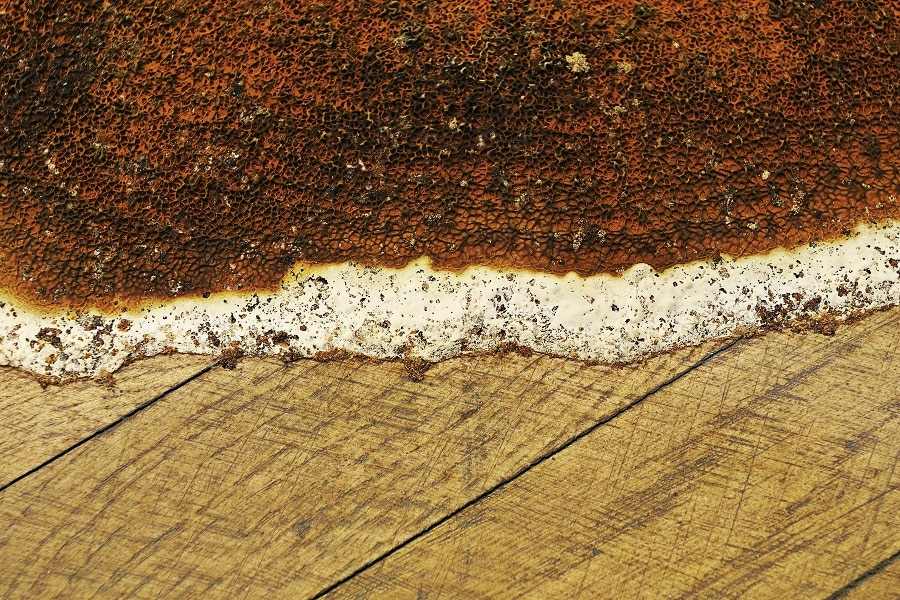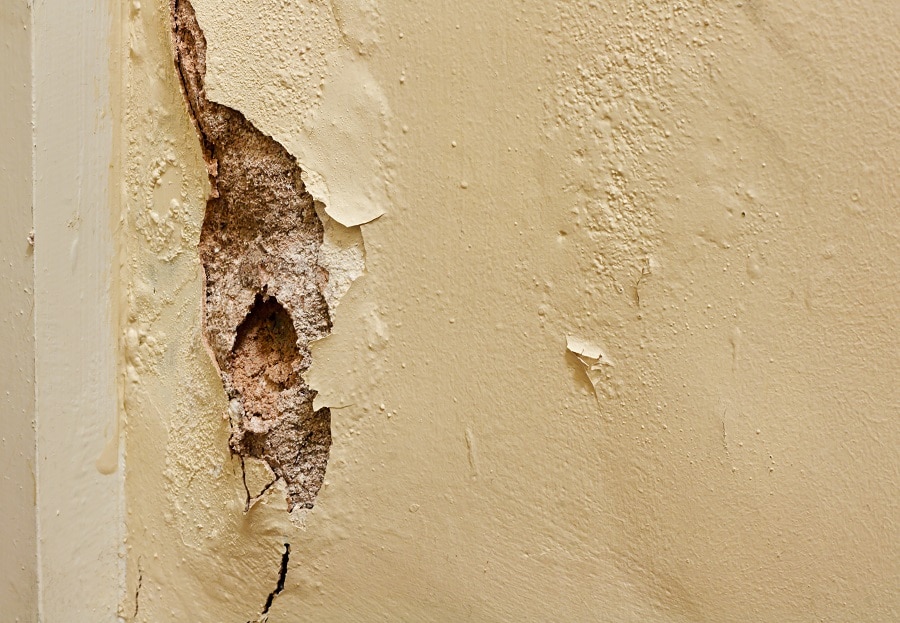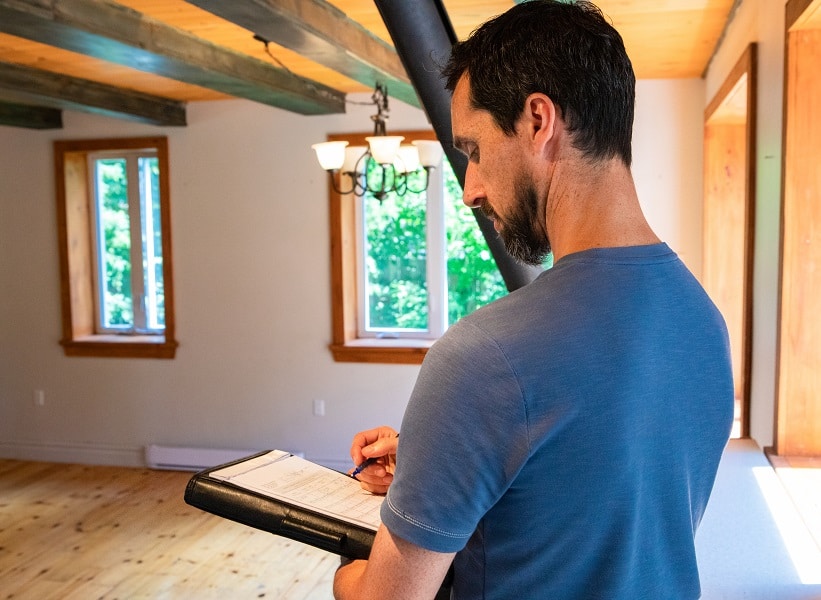What is dry rot?
Dry rot is the general word used for wood-decay fungus. The wood is broken down by fungi, as the Mycelium decomposes the wood, resulting in fine dust particles that are made of sawdust and wood chips, forming colonized areas that are referred to as fungal blooms. Dry rot fungal spores need an adequate place to land and begin their colonies before they disperse through the underlying wood. Soil can be contaminated when it is drilled into, and old wood that has been affected by dry rot could also be a source of contamination.
This means that even treated wood can be re-infected by dry rot if it is damp enough (i.e., below 15 percent relative humidity). Dry Rot causes significantly greater damage than Wet rot, you may be shocked to hear that dry rot fungus can attack the structural timber in your property whilst remaining undetected. It normally occurs where you are not looking. This could be found behind the plaster, beneath your floorboards, or even in your loft. That’s why it’s important to identify the signs and symptoms of dry rot to have it treated fast.
Our Guarantee
- upto 30 year guarantee
- customer focused team
- 20 years combined experience
- portfolio of satified customers
- attention to detail
- Construction line accreditation
- public liability insurance
- CHAS accreditation
What is the difference between dry rot and wet rot?
Dry rot and wet rot are different because they have different species. The biggest difference, however, is that wet rot needs significant moisture to spread. One of the main differences between wet rot and dry rot is that wet rot spreads much faster. This is because it uses the capillaries within timber rather than mycelium that typically forms the basis of a Dry Rot infestation. Dry rot is extremely destructive and spreads quickly through a house, even retaining its ruinous effects if the room has been previously treated for damp or wet rot. Wet rot fungus, on the other hand, happens more frequently but is less serious, usually rotting is limited to areas where the wood becomes and stays wet.
Call Our Sussex Damp Experts team now for quote, consultation and advice:
Call on 01273 257 765.
What are the causes of dry rot?
A number of fungi cause dry rot. The most commonly found in the Hove is Serpula Lacrymans. it can spread from your home’s walls to the floors, and even the plaster is not fixed soon enough. It can have a major negative impact on the structural integrity of timber, and also the integrity of your home. Dry rot attacks when moisture levels are too high in your timber. This will attract the fungus that will then provide nutrients. “Dry rot” is used to distinguish “wet wood” from “dry wood rot.”
Wet wood grazes on a dry rot. Fungal spores require over 30% moisture to generate hyphae, which in turn can survive with 20% moisture. These hyphae can grow into a fungal body called a mycelium, which can also spread to find more timber in stone and brick. The wood fibers (cellulose) are rotten or broken down by the fungus, and the water is removed. You need an expert to examine your property and determine whether your rotting timber is a result of dry rot or a different type of fungus. This is very important as the treatments for these damages will differ depending on the exact cause.

The dangers of dry rot in Hove
Dry Rot Effect on your Property
Dry rot spreads so fast it can possibly cause you to lose your house integrity. Dry Rot will slowly and silently break down the structural timber of your property. In extreme circumstances, this can cause different sections of your home to fall apart. Dry rot does not strike your brick or stone, it just moves through it. This is why regular checks are important.
Dry Rot is a severe issue, which needs immediate maintenance and treatment. When fungus manifests, you should call a Dry Rot Expert immediately to avoid an infestation and deal with the occurring damage quickly. If you suspect you may have a problem with dry rot, check out Sussex Damp Experts today.
Dry Rot Effect on Your personal health
It is not the fungus that causes dry rot that is harmful. Yet, if the conditions in the home allow dry rot to occur, these environmental conditions can be damaging to your health. If you suffer from respiratory problems, asthma or allergies and don’t have a smoke alarm, then this guide is for you.
What are the Warning Signs of Dry Rot?
The sooner you find dry rot, the less time and money you need to waste on treating it. If any of these signs and symptoms are present, a formal evaluation is recommended.
-
The beginning of the dry rot cycle
The spores are carried by wind. The insect cuts small holes into the wood and eats the sap that comes out. When the wood has enough moisture, it allows fungal spores of Armillaria mellea to germinate and create hyphae, if the timber is giving them enough nutrients to do so. Spider web-looking collections called mycelium will join up as the hyphae grow and feed. Mycelium can be light grey to pure white. The mycelium that compose these mushrooms are very powerful and can leach into porous areas like mortar, bricks and plaster to try and reach more timber.
-
Your timber is damaged.
When dry rot is affecting your timber, it will become brittle and dry. Often this can also cause the timber to collapse. You may observe the dry rot changing the color of your timber. Scientists have discovered that dry rot can lead to something called cuboidal cracking. The Cuboidal Cracking is a natural timber feature that affects all timber species and can break the timber up to 50 mm width. At its worst, the fungus rots the timber, causing the white fungal hyphae to grow. Hyphae is a slime-mold and is an early symptom of dry rot.
-
Your timber will smell.
If you detect a distinct dour, you should have your timber checked for dry rot. This can occur even if you can’t see a dry rot outbreak. Despite the odor, dry rot may not yet begun to grow.
-
Your timber will have fungus bodies on it.
It has likely entered the final stage of dry rot and the most obvious. Those cute little mushroom-like fruiting bodies can start joining themselves with your wood. They occur when dry rot can no longer feed on the wood, so the fungus has to churn out spores instead.
-
Your timber will have spore dust.
Spores related to dry rot do not only exist in wood damaged by dry rot. If you are seeing splotches of rusty coloured dust accompanying decomposed spores, it could be a sign of dry rot. Fertile bodies supply this spore dust in the final cycle of dry rot.
Dry Rot Treatment in Hove

Only when the moisture is over 20% will a dry rot invasion take place. Controlling moisture levels in your living space/property is the first preventative step to eradicating the presence of the fungus. You can now control the moisture levels. We advise you to commission an expert in order to treat dry rot.
Sussex Damp Experts are able to assist you with any contaminated timber removal and any remedial works. A professional should remove any infected timber. Similarly, a professional damp proofing expert will know the exact treatment required. Timber can be treated by injection, or covering the timber surface, Options for preventive treatment are many. If inhaled or injected accidentally, these chemicals may cause negative side effects because they require a specific attention.
Your timber may require Boron roads injection from a professional. Boron is a hazardous mineral, so it is important to wear protective clothing whilst damp proofing your basement. Through our damp proofing expert team, we will be able to identify some dry rot problems and determine the seriousness of the problem. Dry rots can be a severe issue and need to be treated right away. If dry rot is not treated promptly, it can spread across your property and do real harm. We will provide a damp proofing solution that is right for your needs. Please don’t wait until it’s too late. If you believe you have a problem with dry rot, call 01273 257 765 for a free survey, and successful care today.
How can you prevent dry rot damage in Hove?
Preventing dry rot is the first step of treatment. Wooden areas of the property, which capture ample water and which are subject to moisture/humidity, can contribute to a dry red infestation. Here are several techniques that will save them from forming: Confirm that your house doesn’t have any leaks. Provide sufficient ventilation.
Properly ventilate and insulate your attic. Oxygenate crawlspaces very well. Stop dirt and moisture from getting into your basement or crawlspace. Check all flashing to make sure there are no leaks and water directed properly. Ensure clear downspouts and drains. It’s a very good idea to check your pipes and heating system for leaks when using a wet system The best way to reduce the chance of dry rot is to minimize moisture levels, considering the moist conditions needed for dry rot fungus in feeding and germinating. For instance, if you plug the leak, you prevent water from flowing into the pipe and causing future damage.
Speak to a Dry Rot specialist in Hove
We are equipped to deal with any damp proofing or dry rot problems affecting your property or home. We’ll do a full steam survey of the property and give you a free estimation before we start any work. Over the years, with their damp concerns, we have helped thousands of Hove homeowners, and we will support you too. Call us now to book a free survey and quote 01273 257 765. An expert will be able to assess your dry rot problem. This helps us to offer unbiased guidance and advice about the sort of care you will require.

As a well-established building company, we have a wealth of experience in all aspects of repair, restoration and renovation including surveys. Dry rot is a long term problem, and can get worse if left unchecked, if you notice any signs of damage on your fence, it is better to contact our contractors right away. Contact Sussex Damp Experts Services for quality damp proofing services on 01273 257 765.
FAQ
Should dry rot be restored or replaced?
A certain level of dry rot can be repaired, but whether the damaged areas provide the house with structural stability, such as beams and joints, or even flooring, it is not recommended. Replace the wood in such a situation instead of repairing it. Whether you restore or rebuild the wood, it is better if you avoided the conditions that caused the rot to flourish in the first place or risked it coming back. Your roof leaks, broken gutters, or downspouts, plumbing leaks or insufficient ventilation should be inspected when considering a roof moisture accumulation You may consult a specialist to find and repair the problem.
Will you be able to treat my Dry Rot problem effectively?
With our expertly trained surveyors and specialists, a dry rot problem can be treated, rectified, and your timber can be protected for the future.
How do I discover how far Dry Rot has spread?
If you have traced the dry rot fungus quickly or not, a professional will identify the source of the problem. They will be able to trace the fungus in the different masonry and plaster from which it has spread.
How much can dry rot widen?
Dry rot spores can spread in anyplace with the right environmental settings. The reason is that they are carried in the atmosphere. If your timber has a moisture content of around 20%, and if it is in the open air, these conditions are attractive to dry rot fungus. This suggests that fungus groups can disperse to multiple materials. If dry rot is spreading across masonry and plaster, and if it reaches more timber to feed off where the timber is moist. It can widen further. Dry rot fungus needs five things to survive: the right temperature, drive rot spores, moisture, oxygen, and the food source. In any home in Brighton most of this is present.
Will dry rot stretch?
What should I do to control dry rot?
First identify the reason for your timber moist before solving it. A different treatment shall be given if the reason for your timber moisture is outside.
What are the effects of living dry rot unchecked?
Dry rot is the most insidious form of moisture that can infest property and cause permanent damage to the building if left untreated. Sometimes, once the harm is already done due to the places in which the problem is likely to be the presence of dry rot does not come to light.
Is dry rot stringent?
Dry rot can be particularly common in wooden properties, so it is essential that early signs of dry rot are identified before the damage becomes too severe.
How am I meant to know if I have dry rot?
A timber survey will assess how your timber is affected by being exposed to moisture. Later on, fruiting bodies and mycelium will be noticeable in the drive rot life-cycle.
Where can dry rot grow?
Dry rot attacks and rots timber that’s been in contact with water for a long period of time. Although it can often be mistaken for other problems in its early stages, it is important to seek advice. In every structure, both old and new, dry rot can grow. The reason being that it is caused by moisture and wetness that happen anyplace. Dry rot can be caused by leaks or weather, meaning the type of property does not affect it.




